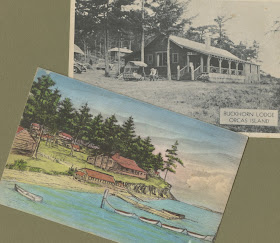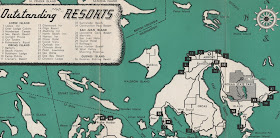 |
| BUCKHORN LODGE The view from the water as mariners, June and Farrar were rowing west to Harnden's beach. From the archives of the Saltwater People Log© |
As we near Buckhorn Lodge, a sleek, new mahogany boat upholstered in blue leather comes flashing out to meet us. Ten seconds ago it was at its moorings, now it is alongside us and Mr. Payson from Tacoma, the owner of these 115 leashed horses, offers us a tow to wherever we are going. We accept. The wind failed some time ago. We've been rowing a long way. A tow for five minutes behind this boat will take us nearer to our night's camp-spot than we could walk with our arms in two or three hours.
The Harndens live somewhere along this north shore. We have an invitation to camp on their beach. It is past six o'clock, time to camp.
People all along here are picnicking down on their beaches, fishing, or sitting on porches, talking dreamily. Houses sit on bluffs, hidden, secret. Or they cluster together low on the beach, friendly, gregarious––but which house is the Harndens'––they who used to live on Sucia Island? 'About a mile down the shore,' a girl shouts out to us. We have let our horses go back too soon.
Slowly, we ease along this shore, looking for a comfortable beach. Underwater boulders left here by the glaciers are strewn over the low tidelands. We'd go aground, or a-rock, on one of those and never get off! On and on.
This is low land, now––the isthmus at the head of East Sound. Just a mile down there is the village. We'll go over there tomorrow and spend the day talking to some of the most interesting old-timers in all the islands.
Sand dollars! My stars, look at them all over the bottom of this bay! Black, standing up on edge, they look even stranger than when we find them on beaches, white and dead, mere skeletons, their star-shaped centers cut out with holes like the doors of an old kitchen safe.
This tall white house with the luscious garden and the flowers, all with such a ship-shape look––this must be the Harndens. I'll just go ashore to say we're camping on their beach tonight––and they are not home.
We camped anyway, not far away, on a shallow beach below the old salt marshes which are now fertile fields. It had the feel of prairie there––a new feel in the islands. We got a sudden sense of homesickness for the prairies of Oklahoma which we both have known. Home! How many places turn out to be home. How many places are wonderful and dear for some sudden sharp likeness to a little spot on which you stood to watch a meadowlark on a fence post, maybe.
But that night another north wind came up. We had awakened to a sunrise clear and pure, the old ball rolling up over Lummi Island and shining straight across to us, still comfortably abed. Then all at once, without the slightest warning, there was the wind and in two minutes flat, surf rolling in over this flat beach.
'We'll be aground in 10 minutes,' Farrer shouted as he ran down the beach, throwing off pajamas and grabbing on garments as he ran. I follow only one button behind him. At the water's edge, we were fully dressed, but we shouldn't have been, for in two more minutes we were fully wet pushing off the boat. But we managed to load it before it could quite come ashore.
And so, away again, breakfastless, tickled at our first brush with surf in our lives.
We'd row on around Point Doughty to Orkila, the YMCA boys' camp, we said. They had invited us. We could dry out there and ––maybe!––they might ask us to breakfast.
But if it had been any later than five o'clock in the morning, we'd never have made it. It took us nearly three hours to row those few miles, for the wind wasn't going our way and, for once, we didn't propose to go its way. Finally, we rounded the point, slide down the bay to Orkila.
And, sure enough, a man came down the beach to meet us. It was Mr. Emory, director of the Queen Anne 'Y' in Seattle. 'You'll have breakfast with us?' he said and we said you bet and in no time at all, boys had secured our boat in the lesser surf on this beach. Boys had built a fire in the big dining room and a day at Orkila had begun.
We met 125 boys and 30 staff members.
 |
| Beach Haven Resort Click to enlarge. Original photos from the archives of the Saltwater People Historical Society© |
We went down the beach to see Mr. Kimple's and his two partners' Beach Haven resort, where Dr. Turner of the University's new medical college caught five salmon the first time he ever fished in our waters, met Mrs. Fleming, wife of Seattle's superintendent of schools, sitting on a log knitting, had some cookies made by Mrs. Kimple. That's all for today! See you tomorrow. June."
If you have been following along with this Log there are many more excerpts from the newspaper articles by June Burn entitled One Hundred Days in the San Juans. She had a contract with the Seattle Post-Intelligencer in 1946. In the 1980s editors with the Longhouse Printcrafters in Friday Harbor, published them in a book format, under the same title. Now a collector's item.


No comments:
Post a Comment